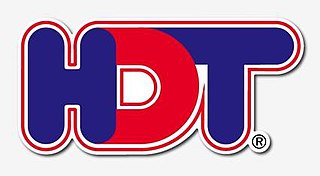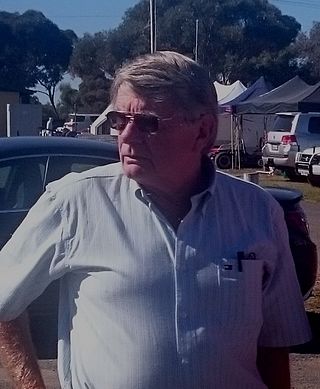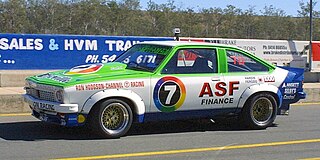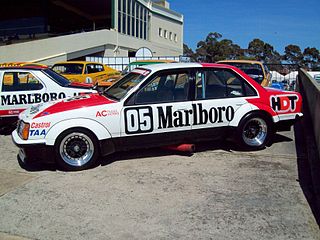Related Research Articles

The Holden Dealer Team (HDT) was Holden's semi-official racing team from 1969 until 1986, primarily contesting Australian Touring Car events but also rallying, rallycross and Sports Sedan races during the 1970s. From 1980 the Holden Dealer Team, by then under the ownership of Peter Brock, diversified into producing modified road-going Commodores and other Holden cars for selected dealers via HDT Special Vehicles.

Colin John Bond is an Australian former racing driver. Bond reached the highest levels in Australian motorsport in 1969 when he was recruited by Harry Firth to the newly formed Holden Dealer Team. He quickly found success, winning the 1969 Hardie-Ferodo 500 mile race at Bathurst, New South Wales in a Holden Monaro.
Allan George MoffatOBE is a Canadian-born Australian racing driver known for his four championships in the Australian Touring Car Championship, six wins in the Sandown 500 and his four wins in the Bathurst 500/1000. Moffat was inducted into the V8 Supercars Hall of Fame in 1999.
The 1981 Australian Touring Car Championship was a CAMS sanctioned motor racing title for drivers of Group C Touring Cars. The championship, which was the 22nd running of the Australian Touring Car Championship, began at Symmons Plains Raceway and ended at Lakeside International Raceway after 8 rounds.

In relation to Australian motorsport, Group C refers to either of two sets of regulations devised by the Confederation of Australian Motor Sport (CAMS) for use in Australian Touring Car Racing from 1965 to 1984. These are not to be confused with the FIA's Group C sports car regulations, used from 1982 to 1992 for the World Endurance Championship / World Sports-Prototype Championship / World Sportscar Championship and the 24 Hours of Le Mans.
The 1979 Hang Ten 400 was an endurance motor race held at the Sandown Park circuit in Victoria, Australia on 9 September 1979. It was staged over 129 laps of the 3.11 km circuit, a total of 401 km. The race was Round 1 of the 1979 Australian Championship of Makes and as such it was open to Group C Touring Cars. It was the fourteenth in a sequence of annual Sandown long distance races. The race was won by Peter Brock.
John Francis Harvey was an Australian racing driver. He was a top Speedcar driver for many years in the 1950s and 1960s, winning many championship races including the NSW Championship for three successive years and the Victorian Championship twice before turning his skills to road racing where he had a long and successful career until his retirement at the end of 1988. In 1987 John made history driving the General Motors Sunraycer to victory in the inaugural World Solar Challenge from Darwin to Adelaide, the first international race for purely solar powered cars.
The 1988 Australian Touring Car Championship was a CAMS sanctioned motor racing title for drivers of Group 3A Touring Cars. It was the 29th running of the Australian Touring Car Championship. The championship began on 6 March at Calder Park Raceway and ended on 17 July at Oran Park Raceway after nine rounds.
The 1984 Australian Touring Car Championship was a motor racing competition for Group C Touring Cars. The Championship was authorised by the Confederation of Australian Motor Sport as an Australian National Title. It was the 25th Australian Touring Car Championship, and the last to be contested by Group C cars as new regulations, based on international Group A, were introduced for 1985.
The 1985 Australian Touring Car Championship was a CAMS sanctioned motor racing title for drivers of Touring Cars. It was the 26th running of the Australian Touring Car Championship and the first to be contested using regulations based on the FIA's International Group A regulations after having been run under CAMS home grown Group C rules between 1973 and 1984. The championship began on 10 February 1985 at Winton Motor Raceway and ended on 14 July at Oran Park Raceway after ten rounds.
The 1979 Australian Touring Car Championship was a CAMS sanctioned Australian motor racing title open to Group C Touring Cars. It began at Symmons Plains and ended at Adelaide International Raceway after eight rounds. The title, which was the 20th Australian Touring Car Championship, was won by Bob Morris driving a Holden Torana.
The 1982 Australian Touring Car Championship was a CAMS sanctioned Australian motor racing title open to Group C Touring Cars. It began on 18 February 1982 at Sandown Raceway and ended on 16 May at Oran Park Raceway after eight rounds. The title, which was the 23rd Australian Touring Car Championship, was won by defending champion Dick Johnson, driving a Ford XD Falcon.

The 1983 Australian Touring Car Championship was a CAMS sanctioned motor racing title for drivers of Group C Touring Cars. The title, which was the 24th Australian Touring Car Championship, was contested over a series which began on 6 February 1983 at Calder Park Raceway and ended on 19 June at Lakeside International Raceway after eight rounds.
The 1978 Australian Touring Car Championship was a CAMS sanctioned Australian motor racing title open to Group C Touring Cars. The title, which was the 19th Australian Touring Car Championship, was won by Peter Brock. It was his second Australian Touring Car Championship victory.
The 1977 Australian Touring Car Championship was a CAMS sanctioned Australian motor racing championship open to Group C Touring Cars. It was the 18th running of the Australian Touring Car Championship. The championship began at Symmons Plains Raceway on 7 March and ended at the Phillip Island Grand Prix Circuit on 20 November after eleven rounds. 1977 was the second and final time that the series incorporated the longer distance races which made up the Australian Championship of Makes. These races included the Sandown 400 and the Phillip Island 500K, although notably not the Bathurst 1000.
The 1972 Australian Touring Car Championship was a CAMS sanctioned national motor racing title open to Group C Improved Production Touring Cars and Group E Series Production Touring Cars. The championship, which was the 13th running of the Australian Touring Car Championship, began at Symmons Plains and ended at Oran Park after eight rounds.
The 1973 Australian Touring Car Championship was an Australian motor racing competition for Group C Touring Cars. It began at Symmons Plains on 5 March 1973 and ended at Warwick Farm after eight rounds. The championship, which was authorised by the Confederation of Australian Motor Sport as an Australian National Title, was the 14th running of the Australian Touring Car Championship.
The 1974 Australian Touring Car Championship was an Australian motor racing competition open to Group C Touring Cars. Authorised by the Confederation of Australian Motor Sport as an Australian National Title, it was the 15th running of the Australian Touring Car Championship. The championship began at Symmons Plains on 4 March 1974 and ended at Adelaide International Raceway on 9 June after eight rounds.

The 1980 Australian Touring Car Championship was an Australian motor racing competition for Group C Touring Cars. Authorised by the Confederation of Australian Motor Sport as a National Title, it was the 21st Australian Touring Car Championship.
The 1982 Australian Endurance Championship was a CAMS sanctioned Australian motor racing championship for Group C Touring Cars. It was the second Australian Endurance Championship and the first to incorporate titles for both drivers and makes. The Drivers title was awarded to Allan Moffat and the Makes title to Nissan.
References
- 1 2 3 4 5 6 7 8 9 10 11 12 13 14 15 16 17 18 Australian Title Conditions, 1976 CAMS Manual of Motor Sport, pages 81 to 85
- 1 2 3 Australian Titles, docs.cams.com.au As archived at www.webcitation.org on 31 October 2013
- ↑ Howard, Graham; Wilson, Stewart (1986). "1976: Moffat bounces back". Australian Touring Car Championship 25 fabulous years. R&T Publishing. pp. 168–176. ISBN 0-9590378-2-9.
- ↑ Moffat back in race Canberra Times 5 June 1976 page 36
- ↑ Moffat smiling Canberra Times 7 June 1976 page 16
- 1 2 Ray Bell, Australian Touring Car Championship - Rd. 5, Amaroo Park Racing Car News May 1976 page 72
- 1 2 Official programme, Hang Ten 400, Sept 12 (1976)
- ↑ Tom Naughton, Moffat's action-packed Calder Racing Car News April 1976 page 76
- 1 2 Australian Touring Car Championship, Australian Competition Yearbook, 1977 Edition, pages 48 to 73
- ↑ "1976 ATCC". The Programme Covers Project. Retrieved 14 February 2019.
- ↑ Brock Torana races away in record 300 The Courier-Mail 8 November 1976 page 18
- 1 2 3 4 Graham Howard, Stewart Wilson & David Greenhalgh, 1976 ATCC, The Official History of Australian Touring Car Championship – 50 Years, page 169